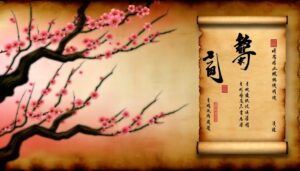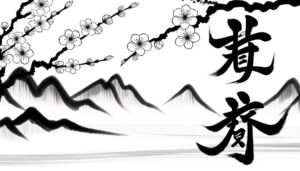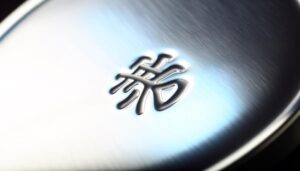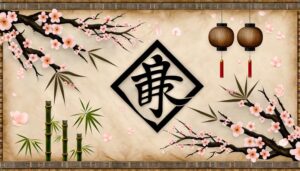What Is the Chinese Symbol for Bad Luck?
In Chinese culture, several symbols are associated with bad luck, each with its own cultural significance. Noteworthily, the number four is considered unlucky due to its phonetic similarity to the word for 'death.' Black and white colors are intertwined with negativity and mourning.
Symbolism extends to broken mirrors, believed to disrupt harmony and invite misfortune. Gifting clocks is also seen as inauspicious, given the association with the end of life.
Moreover, the hoot of an owl is perceived as a bad omen, and sharp objects are avoided during significant events. For deeper insights into these symbols, explore further.
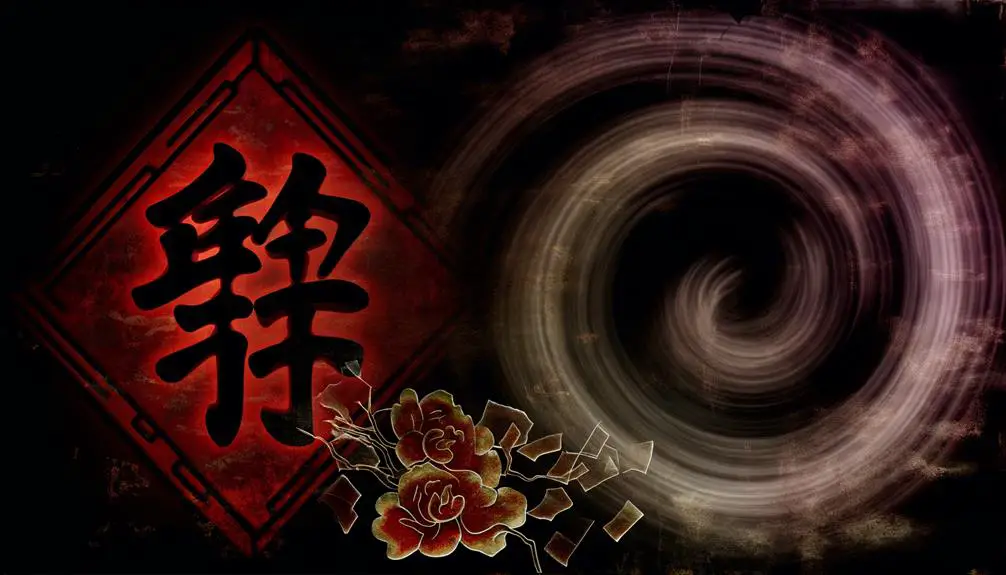
Key Takeaways
- The number four is considered bad luck in Chinese culture due to its phonetic similarity to the word for 'death.'
- Black and white colors symbolize negativity and mourning, respectively, contributing to their inauspicious connotations.
- Broken mirrors are believed to attract negative energy and disrupt harmony, making them symbols of bad luck.
- An empty red envelope, or 'hóngbāo,' signifies disrespect and misfortune in Chinese traditions.
- Owls are viewed as omens of misfortune, signaling impending doom or disaster.
The Number Four
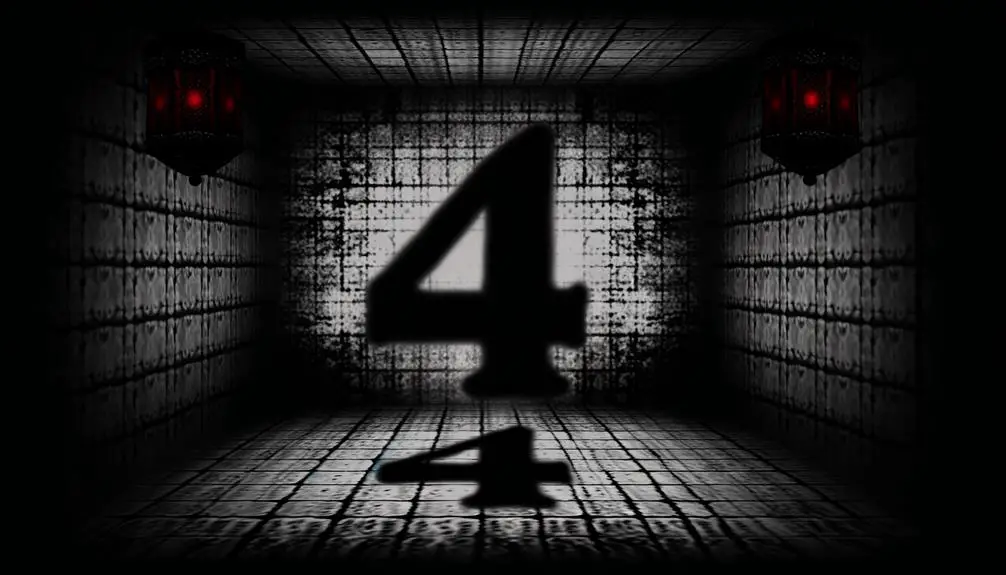
In Chinese culture, the number four is often associated with bad luck due to its phonetic similarity to the word for 'death.' This homophonic resemblance is more than a mere linguistic coincidence; it is deeply embedded in the cultural psyche, influencing behaviors and practices.
For instance, many buildings in China omit the fourth floor, similar to how Western buildings sometimes skip the 13th floor. This aversion extends to various aspects of life, including phone numbers, addresses, and even gifting, where items in sets of four are avoided.
The impact of this belief is pervasive, affecting both individual and collective decision-making processes. Understanding this cultural nuance is essential for anyone engaging with Chinese society, as it underscores a significant aspect of their superstitions and traditions.
Black and White Colors
In Chinese culture, the colors black and white carry profound symbolic meanings that extend to perceptions of luck and misfortune. Black is often associated with darkness, evil, and negativity.
White, contrary to its Western association with purity, is linked to death and mourning. These cultural taboos around black and white contribute greatly to their roles as symbols of bad luck in various contexts.
Cultural Symbolism of Colors
The cultural symbolism of black and white colors in Chinese tradition is deeply intertwined with notions of yin and yang, representing a balance of opposing forces.
Black (黑 hēi) is associated with water, the moon, and the feminine yin, embodying mystery, depth, and the unknown.
Conversely, white (白 bái) represents purity, metal, the sun, and the masculine yang, symbolizing clarity, brightness, and life.
This duality is essential in Chinese cosmology, reflecting the harmonious interplay of darkness and light. Understanding these colors transcends mere aesthetic value; it explores the philosophical foundation of balance and harmony.
Therefore, color symbolism in Chinese culture is a profound expression of natural and metaphysical principles, integral to daily life and spiritual beliefs.
Black and White Taboos
Beyond their philosophical significance, black and white colors also carry specific taboos in Chinese culture that influence social practices and traditions. Black, often associated with darkness and negativity, is generally avoided in celebrations and gifts. Conversely, white symbolizes mourning and death, making it unsuitable for joyous events such as weddings. These taboos are deeply rooted in traditional beliefs and continue to shape contemporary customs. The table below outlines key taboos associated with these colors:
| Color | Symbolism | Taboos |
|---|---|---|
| Black | Darkness, Negativity | Avoided in celebrations and gifts |
| White | Mourning, Death | Unsuitable for weddings and festive occasions |
| Black | Misfortune | Often linked to bad luck and evil spirits |
| White | Purity (rarely) | Sometimes seen in funerary contexts only |
| Black | Formality | Reserved for somber, formal events |
Understanding these taboos is essential for respectful cultural interactions.
Broken Mirrors
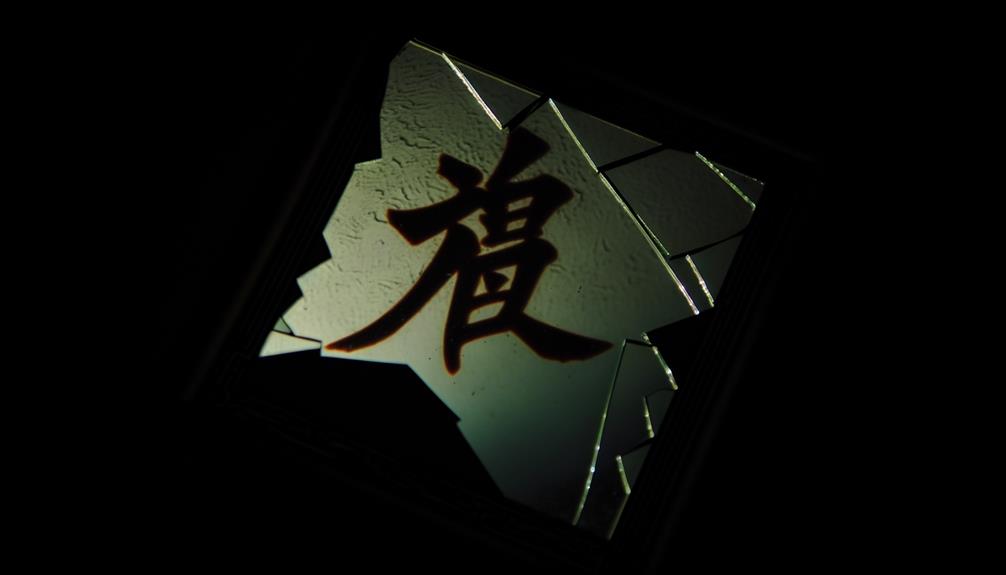
The concept of broken mirrors as harbingers of bad luck has deep roots in Chinese culture. It originated from ancient beliefs that mirrors possess the ability to reflect one's soul. These beliefs are still prevalent today, influencing modern practices such as Feng Shui. In Feng Shui, broken mirrors are considered to disrupt harmony and attract negative energy.
Understanding this cultural significance requires examining both historical contexts and contemporary implications.
Origin and Beliefs
Rooted in ancient Chinese superstition, the belief that shattered mirrors bring bad luck reflects deep-seated cultural anxieties about fractured reflections symbolizing disrupted fortunes.
Historically, mirrors were not simply utilitarian objects but revered artifacts, believed to hold mystical properties. In Chinese culture, mirrors were thought to capture and reflect the soul. Hence, breaking a mirror was akin to harming one's spirit and inviting misfortune.
This fear was compounded by the idea that mirrors acted as gateways to other dimensions, and breaking one could release negative energies or malevolent spirits. Consequently, the superstition surrounding broken mirrors became entrenched in the collective psyche, intertwining with broader themes of harmony, balance, and the cosmic order fundamental to Chinese philosophical thought.
Cultural Impact Today
Today, the ancient superstition of broken mirrors continues to influence Chinese cultural practices and societal behaviors, reflecting enduring concerns about misfortune and spiritual disturbance.
In modern Chinese society, broken mirrors are often perceived as harbingers of bad luck, leading to immediate disposal to prevent negative energy from spreading. This belief extends beyond households, affecting business environments where maintaining harmony and fortune is paramount. Rituals to counteract the ill effects, such as using red paper to cover broken mirror shards, are still practiced.
Moreover, the superstition impacts architecture and interior design, where mirrors are strategically placed to avoid potential breakage and its associated misfortunes. These practices underscore the deep-rooted cultural integration of this age-old belief.
The Empty Red Envelope
Presenting an empty red envelope, traditionally known as 'hóngbāo,' is considered a significant omen of bad luck in Chinese culture. The hóngbāo, typically filled with money, symbolizes good fortune, prosperity, and the transfer of blessings from the giver to the recipient.
An empty hóngbāo, in stark contrast, signifies a lack of goodwill and is perceived as a gesture of disrespect or misfortune. The act undermines the cultural expectation of generosity and can lead to strained relationships.
From an analytical perspective, this practice underscores the intricate social rituals that dictate harmonious interactions in Chinese society. Such customs reflect the deep-seated belief in reciprocity, where giving with sincerity is essential to maintaining social balance and auspiciousness.
Clocks as Gifts
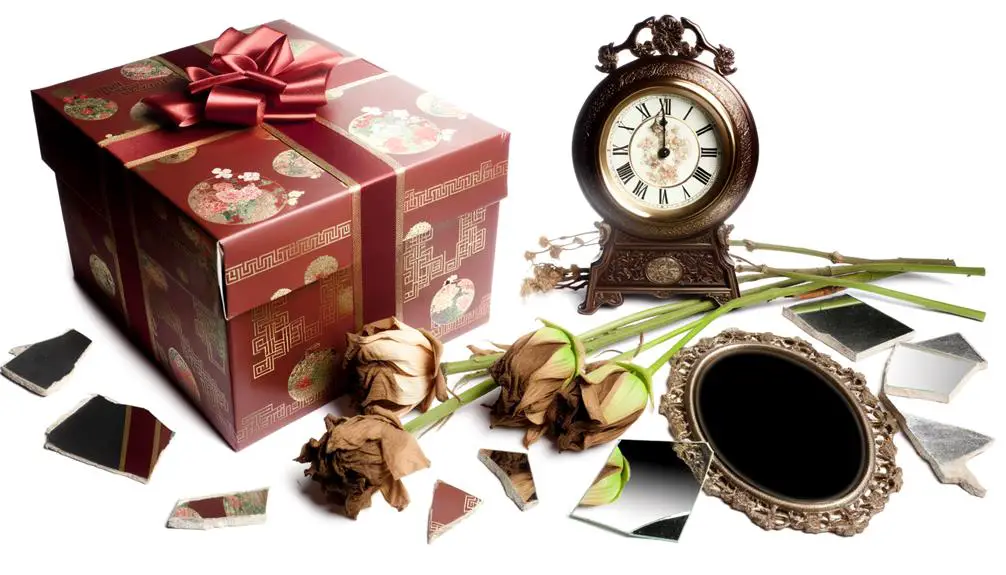
Why is gifting clocks considered a harbinger of bad luck in Chinese culture?
This belief stems from linguistic nuances and cultural interpretations. The Chinese phrase for 'giving a clock' (送钟, sòng zhōng) sounds phonetically similar to 'attending a funeral ritual' (送终, sòng zhōng). This homophonic resemblance links clocks to the notion of death and finality, making them an ill-fated gift.
Additionally, clocks measure the passage of time, symbolizing the finite nature of life. As a result, presenting a clock as a gift can be interpreted as counting down the recipient's remaining time, which is deemed inauspicious.
This cultural sensitivity underscores the importance of understanding linguistic and symbolic connotations in gift-giving practices within Chinese society.
The Crying Doll
In Chinese culture, the crying doll is considered an ominous symbol due to its association with sorrow and misfortune. This belief is deeply rooted in cultural narratives and superstitions that regard the act of crying as an invitation for negative energies.
The crying doll, often depicted with teardrops and a sorrowful expression, is thought to embody the following:
- Emotional Distress: The doll symbolizes unresolved grief and emotional turmoil.
- Negative Energy: It is believed to attract misfortune and bad luck into the household.
- Symbolic Representation: The tears on the doll serve as a constant reminder of sadness and setbacks.
Understanding these cultural symbols allows for a deeper appreciation of the nuanced beliefs that shape Chinese perceptions of luck and misfortune.
Unlucky Flowers
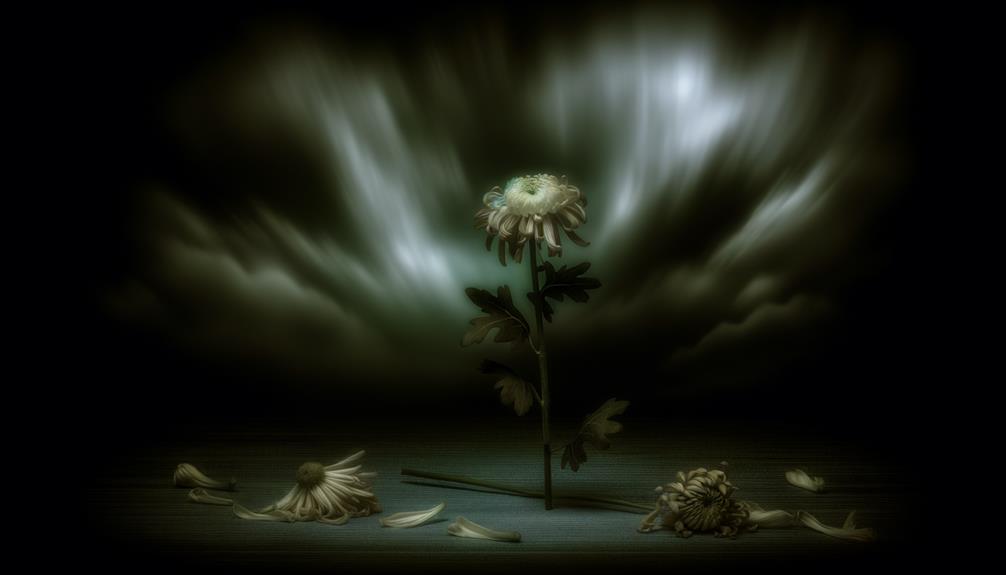
In Chinese culture, certain flowers are imbued with significant symbolic meanings, often associated with misfortune. White chrysanthemums, for instance, are traditionally linked to funerals and mourning, representing sorrow and bad luck.
Conversely, gifting red flowers can be perceived as inauspicious due to their association with blood and conflict, making both choices culturally sensitive and potentially unwelcome.
White Chrysanthemums Symbolism
White chrysanthemums, deeply rooted in Chinese culture, are often associated with funerals and mourning, symbolizing bad luck and misfortune. These flowers, traditionally used in funeral arrangements, evoke strong emotions tied to loss and grief. The cultural symbolism of white chrysanthemums extends beyond their physical appearance to embody deeper meanings of sorrow and finality.
- Funeral Usage: Mainly featured in funeral rites, white chrysanthemums represent death and the ephemeral nature of life.
- Symbol of Mourning: In Chinese customs, these flowers are synonymous with mourning, making them inappropriate for celebratory occasions.
- Cultural Taboos: Gifting white chrysanthemums outside of a mourning context is considered highly unfortunate, potentially inviting misfortune.
Understanding these cultural nuances is essential for appreciating the profound significance of white chrysanthemums in Chinese tradition.
Red Flowers Misfortune
While white chrysanthemums are emblematic of mourning in Chinese culture, red flowers carry their own set of associations with bad luck and misfortune. Unlike the auspicious red often seen during celebrations, red flowers, specifically red roses and red peonies, are sometimes believed to symbolize blood and chaos.
This misinterpretation can make them inappropriate for certain contexts, such as hospital visits or funerals, where they may be perceived as inauspicious. Additionally, the vibrant red hue may evoke notions of anger or wrath in interpersonal relationships.
Understanding these nuanced cultural perceptions is essential for successfully engaging in social interactions and ceremonies within Chinese society. A well-informed approach guarantees respect for traditions and mitigates the risk of unintended offense.
The Inauspicious Owl
Historically, the owl has been considered an omen of misfortune and ill fate in various Chinese cultural contexts. This nocturnal bird, often associated with darkness and death, has long been viewed with suspicion.
In Chinese folklore, the owl's hoot is believed to herald impending doom or disaster. This negative perception stems from several specific cultural beliefs:
- Death and Mourning: Owls are thought to be harbingers of death, often appearing before a family member passes away.
- Ill Health: Sightings of owls are interpreted as warnings of forthcoming illness or health issues.
- Bad Luck in Business: Owls are believed to bring bad fortune, particularly in financial endeavors.
These associations underline the owl's role as a potent symbol of bad luck in Chinese traditions.
Sharp Objects
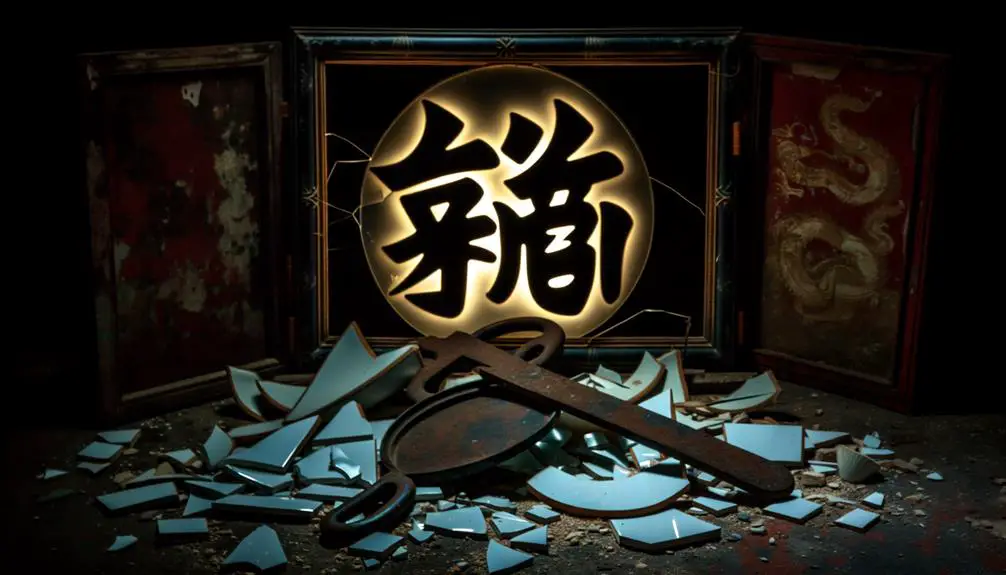
Sharp objects, including knives, scissors, and other bladed instruments, have long been associated with bad luck and negative energy in Chinese culture. This belief stems from the symbolic potential of these items to sever relationships and disrupt harmony.
Traditional Chinese customs advise against gifting sharp objects as presents, as doing so is believed to cut the bonds of friendship or family ties. Additionally, sharp objects are often avoided during significant life events, such as weddings or New Year celebrations, to prevent any misfortune or ill omens.
The aversion to sharp objects is deeply ingrained in Chinese societal norms, reflecting an intricate balance between symbolism and cultural practices aimed at preserving unity and prosperity.
The Chinese Zodiac
The Chinese Zodiac, a fundamental aspect of Chinese astrology, consists of a twelve-year cycle with each year represented by a specific animal sign, influencing the fortunes and personalities of individuals born under each sign.
Each animal—such as the Rat, Ox, or Tiger—carries particular traits and connotations that play a significant role in determining luck and destiny. The system is deeply rooted in Chinese culture and is used to predict compatibility, career prospects, and even health outcomes.
- Rat: Known for intelligence and resourcefulness, but can be perceived as overly ambitious.
- Ox: Symbolizes diligence and reliability, though sometimes considered stubborn.
- Tiger: Represents bravery and confidence, yet may also be seen as impetuous.
Understanding these signs offers insight into individual characteristics and potential challenges.
The Bat Symbol
Interpreting the bat symbol in Chinese culture reveals a fascinating dichotomy, as it simultaneously represents both good fortune and misfortune depending on the context. The character for bat, '蝠' (fú), is a homophone for the word '福' (fú), meaning happiness or blessings. Consequently, bats are often depicted in traditional Chinese art and artifacts as symbols of prosperity and longevity.
However, the nocturnal nature of bats and their association with darkness have also led to interpretations of malevolence and bad luck. This duality is particularly evident in modern times, where bats are sometimes linked to negative connotations such as disease. Understanding the nuanced meanings of symbols like the bat is essential for a thorough grasp of Chinese cultural and historical contexts.
Conclusion
Various symbols and objects are considered harbingers of bad luck in Chinese culture. This includes the number four, specific colors, broken mirrors, and empty red envelopes. These elements are deeply rooted in cultural beliefs and historical contexts, serving as cautionary reminders of potential misfortune.
While some may argue that these superstitions lack empirical evidence, their significance lies in the cultural heritage and collective consciousness they represent. This warrants respect and understanding from both insiders and outsiders.

